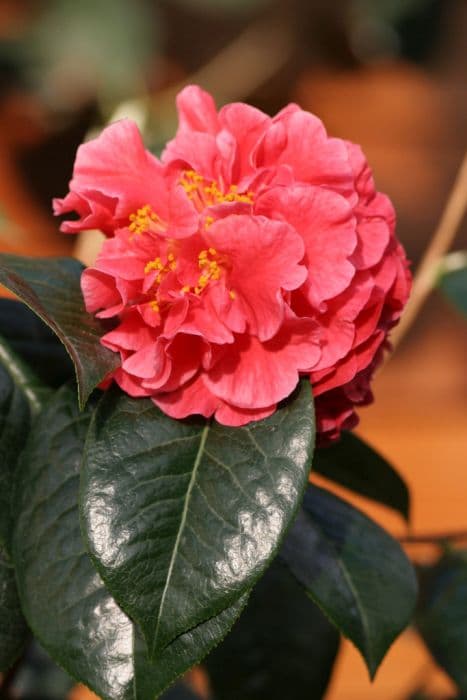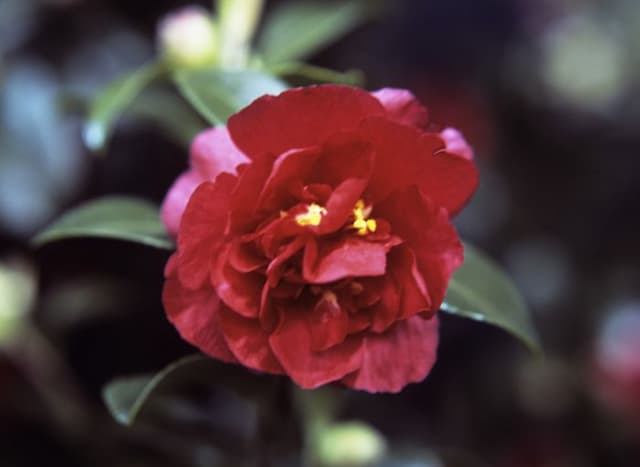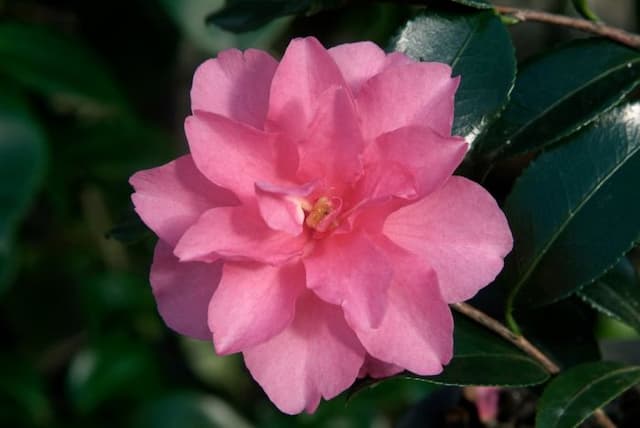Sasanqua Camellia Camellia sasanqua 'Rainbow'

ABOUT
Camellia sasanqua 'Rainbow' is an ornamental shrub known for its showy flowers and glossy, evergreen foliage. The leaves are dark green in color, oval to elliptical in shape, with a slightly serrated edge. The flowers are the standout feature of this plant, typically blooming in the cooler months of fall through winter. The blossoms of 'Rainbow' can vary in color, often presenting a blend of soft pinks to deeper rose shades, with some flowers even displaying a mix of pink and white. These petals have a slightly ruffled appearance, which adds to their visual appeal. The center of each flower is adorned with a cluster of contrasting yellow stamens, which stand out against the pink petals. 'Rainbow' has a graceful growth habit, with branches that may arch elegantly under the weight of the blooms. The overall impression of the Camellia sasanqua 'Rainbow' is one of delicate beauty, with its flowering display bringing color to the garden when many other plants have ceased to bloom. It is commonly used in residential landscapes for ornamental purposes due to its aesthetic flowers and foliage.
About this plant
 Names
NamesFamily
Theaceae.
Synonyms
Sasanqua Camellia, Christmas Camellia, Winter Camellia.
Common names
Camellia sasanqua 'Rainbow'
 Toxicity
ToxicityTo humans
The sasanqua camellia is not considered toxic to humans. There are no significant toxic effects reported for ingestion of this plant by humans, and it is generally regarded as safe. Therefore, no symptoms of poisoning are expected from ingesting parts of the sasanqua camellia.
To pets
The sasanqua camellia is also not considered toxic to pets. It is not known to cause any significant toxic effects if pets ingest parts of this plant. There should be no symptoms of poisoning or severe consequences associated with the ingestion of the sasanqua camellia by pets.
 Characteristics
CharacteristicsLife cycle
Perennials
Foliage type
Evergreen
Color of leaves
Green
Flower color
Varies
Height
4-5 feet (1.2-1.5 meters)
Spread
5-7 feet (1.5-2.1 meters)
Plant type
Shrub
Hardiness zones
7
Native area
Japan
Benefits
 General Benefits
General Benefits- Ornamental Value: Sasanqua camellia's blooms add aesthetic appeal to gardens with their vibrant, multicolored petals.
- Long Blooming Season: It flowers from fall to winter, providing color during months when other plants may not be blooming.
- Drought Tolerance: Once established, sasanqua camellia is relatively drought-tolerant, requiring less frequent watering than some other plants.
- Shade Tolerance: It can grow in partial shade, making it suitable for understory planting or north-facing gardens.
- Evergreen Foliage: The plant retains its leaves throughout the year, offering consistent greenery and structure in the landscape.
- Privacy Screening: With its dense growth habit, sasanqua camellia can be used as a privacy screen or hedge.
- Versatility in Landscaping: It can be trained as a small tree, espalier, or topiary, providing flexibility in garden design.
- Attract Wildlife: The flowers attract pollinators like bees, aiding in the local ecosystem's health.
- Low Maintenance: It requires minimal pruning and is relatively pest- and disease-resistant, making it an easy-care option for gardeners.
 Medical Properties
Medical PropertiesThis plant is not used for medical purposes.
 Air-purifying Qualities
Air-purifying QualitiesThis plant is not specifically known for air purifying qualities.
 Other Uses
Other Uses- Ornamental Hedge: Camellia sasanqua 'Rainbow' can be trimmed and maintained as a dense hedge for privacy or to delineate garden spaces.
- Topiary Art: Its trainable branches and evergreen leaves make it suitable for topiary, allowing gardeners to sculpt it into various shapes and forms.
- Bonsai: The plant can be miniaturized into a bonsai, adding an exotic and artistic element to indoor or outdoor displays.
- Erosion Control: This camellia species can be used on slopes or banks to help prevent soil erosion due to its root structure.
- Photo Backdrop: The vibrant flowers and glossy leaves can serve as a picturesque backdrop for photography, especially during its blooming season.
- Windbreak: When planted in rows, Camellia sasanqua 'Rainbow' can act as a windbreak, protecting gardens from strong winds.
- Fragrant Garden Addition: The subtle fragrance of the flowers can contribute to a sensory garden experience.
- Container Gardening: It can thrive in containers on patios or balcony gardens where ground space is limited.
- Foundation Planting: This camellia variety is often used for foundation plantings around homes to enhance curb appeal.
- Fall Interest: As it flowers in the fall, it provides color and interest in gardens at a time when many other plants are fading.
Interesting Facts
 Feng Shui
Feng ShuiThe Camellia is not used in Feng Shui practice.
 Zodiac Sign Compitability
Zodiac Sign CompitabilityThe Camellia is not used in astrology practice.
 Plant Symbolism
Plant Symbolism- Perfection and Excellence: The Camellia flower is often associated with perfection due to its perfectly arranged petals and lush appearance.
- Love and Admiration: Camellias are considered a symbol of love and are gifted to express desire, passion, or deep admiration for someone.
- Longevity and Faithfulness: With its evergreen quality and long blooming period, Camellias represent the enduring nature of life and are symbolic of faithfulness in relationships.
- Refinement and Elegance: Because of their upscale association and status as an emblem of sophistication, Camellias symbolize the finer things in life and social prominence.
 Water
WaterThe Sasanqua camellia should be watered deeply and thoroughly to ensure the root system receives adequate moisture, allowing about 1 to 1.5 gallons of water per week for established plants. During the growing season and especially in dry conditions, it may be necessary to water twice a week. Younger or recently planted Sasanqua camellias may require more frequent watering to keep the soil evenly moist. It's important to avoid overwatering as this can lead to root rot, so ensure the soil is well-draining. Reduce watering in the winter when the plant is not actively growing.
 Light
LightSasanqua camellias thrive in partial shade, where they can be protected from the harsh afternoon sun. An ideal spot would offer morning sun and dappled shade in the afternoon, which helps to keep the flowers from fading and protects the foliage. They can adapt to full sun in cooler climates if they have adequate moisture, but a semi-shaded location mimics their natural understory habitat.
 Temperature
TemperatureSasanqua camellias are hardy in a range of temperatures but perform best when the temperature is between 60°F and 80°F. They can tolerate minimum winter temperatures down to about 10°F and should be protected if the temperature approaches this lower limit. High temperatures can be tolerated as long as the plants are not in direct afternoon sunlight and receive enough water to prevent heat stress.
 Pruning
PruningPrune Sasanqua camellias after they finish blooming to shape the plant or remove any dead or diseased branches. It is not necessary to prune regularly; however, occasional thinning can promote good air circulation. The best time for pruning is from late winter to early spring before new growth starts.
 Cleaning
CleaningAs needed
 Soil
SoilSasanqua camellias require well-draining, acidic soil with a pH between 5.5 and 6.5. The best soil mix can be created using a combination of 2 parts peat moss, 1 part perlite, and 1 part pine bark to ensure proper aeration and drainage.
 Repotting
RepottingSasanqua camellias typically require repotting every 2 to 3 years to prevent them from becoming root-bound and to replenish the soil nutrients. Repotting is best done in late winter or early spring before new growth begins.
 Humidity & Misting
Humidity & MistingSasanqua camellias thrive in moderate to high humidity levels, ideally between 40-60%. They will also benefit from regular misting if grown in drier indoor environments.
 Suitable locations
Suitable locationsIndoor
Place sasanqua camellia near bright, indirect light and away from drafts.
Outdoor
Plant in partial shade, sheltered from hot afternoon sun.
Hardiness zone
7-9 USDA
 Life cycle
Life cycleThe life cycle of the Sasanqua Camellia 'Rainbow' begins with seed germination, occurring in a warm, moist environment over several weeks to months. After germination, the seedling emerges, developing its initial root system and first leaves, and entering the vegetative growth stage where it focuses on developing foliage and branching. This camellia typically experiences a period of rapid growth in spring and summer. The plant then enters the reproductive stage, forming flower buds that blossom into the characteristic pink-streaked flowers during the fall and winter months. After pollination, often by bees or other insects, the flowers fade and seed pods form, which will mature and eventually disperse seeds, completing the cycle. The Sasanqua Camellia 'Rainbow' is an evergreen shrub, maintaining its leaves year-round and can repetitively go through its flowering cycle for many years, given ideal growing conditions.
 Propogation
PropogationPropogation time
Spring-Early Summer
Camellia sasanqua 'Rainbow', often simply referred to as sasanqua camellia, can be propagated most effectively through semi-hardwood cuttings. This method is most commonly undertaken in late summer after flowering when the new growth has begun to mature and harden slightly. To propagate sasanqua camellia, select a healthy stem and cut a 4 to 6-inch segment, making sure to include several leaves. The bottom inch of the cutting should be stripped of leaves and dipped in rooting hormone to encourage root development. The cutting is then placed in a moist potting mix within a container, ensuring that the leafless portion is buried, and the remaining leaves are above the soil surface. The container needs to be kept in a warm, humid environment out of direct sunlight, and the soil must stay consistently moist but not waterlogged. With ideal conditions, roots will develop in several weeks, after which the new plant can be gradually acclimatized to ambient conditions.









